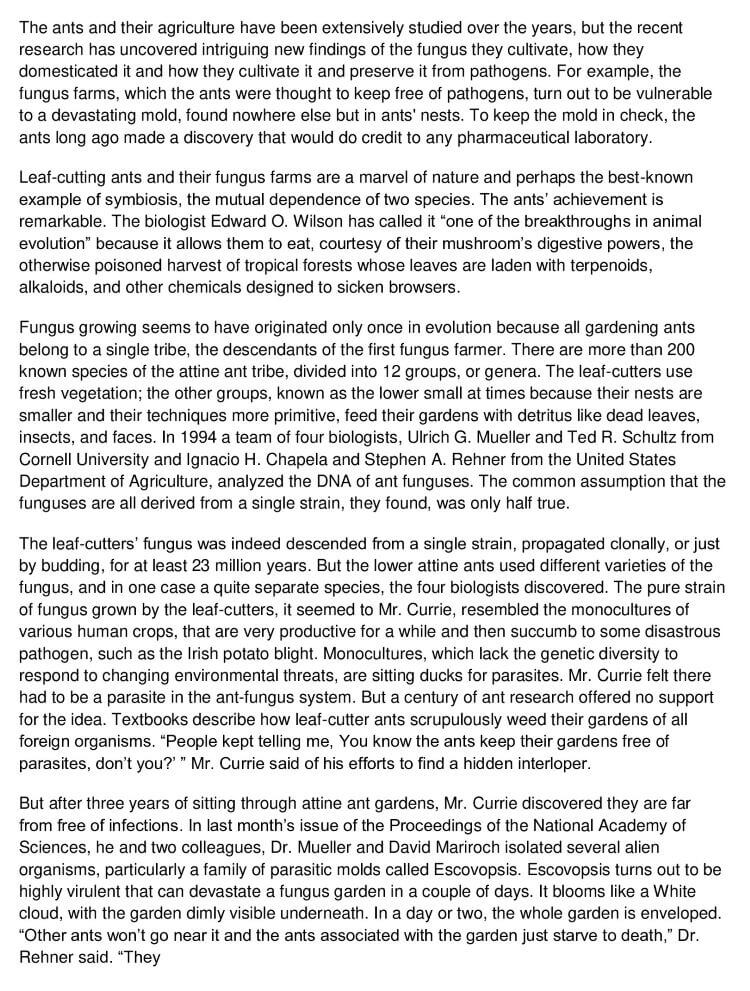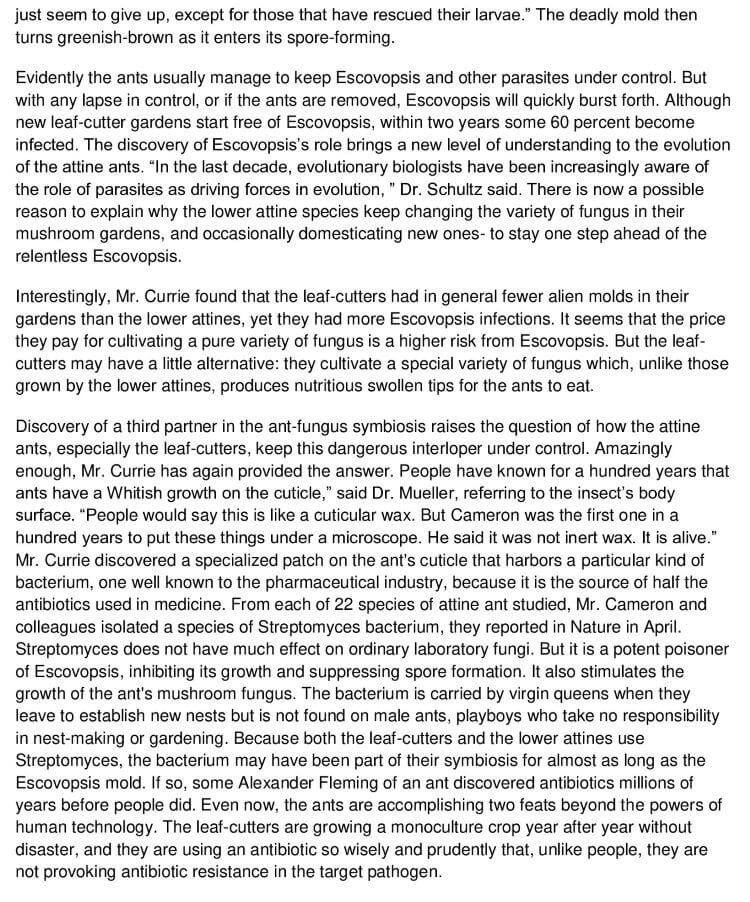Leaf-cutting Ants and Fungus - IELTS Reading Answers
6 min read
Updated On
-
Copy link
Practice this IELTS reading passage on 'Leaf-cutting Ants and Fungus' to ace your exam!
Table of Contents

Limited-Time Offer : Access a FREE 10-Day IELTS Study Plan!
The IELTS Reading Module of the IELTS can be the top-scoring category, with diligent practice. To achieve the best results in this section, you must understand how to approach and answer the different Question types in the Reading Module. By solving and reviewing Sample IELTS reading practice tests, you can ensure that your Reading skills are up to the mark.
Reading Passage
Leaf-cutting Ants and Fungus


Questions 14-19
Use the information in the passage to match the options (listed A-C) with activities or features of ants below.
Write the appropriate letters A-C in boxes 14-19 on your answer sheet.
NB you may use any letter more than once
A . Leaf-cutting ants
B . Lower attines
C . Both
Question 14. Use toxic leaves to feed the fungus.
Question 15. Build small nests and live with the different foreign fungi.
Question 16. Use dead vegetables to feed the fungus.
Question 17 Raise a single fungus that doesn’t live with other foreigners.
Question 18. normally keep a highly dangerous parasite under control
Question 19. use special strategies to fight against Escovopsis
Questions 20-24
The reading Passage has ten paragraphs A-J.
Which paragraph contains the following information?
Write the correct letter A-J, in boxes 20-24 on your answer sheet.
Question 20. The dangerous outcome of Escovopsis.
Question 21. The disadvantage of growing a single fungus.
Question 22. Comparison of features of two different nests.
Question 23. Two achievements were made by ants earlier than humans.
Question 24. advantage of growing a new breed of fungus.
Questions 25-26
Choose the correct letter, A, B, C, or D.
Write your answers in boxes 25-26 on your answer sheet.
Question 25 How does the author think of Currie’s opinion?
A his viewpoint was verified later.
B earlier study has sufficient evidence.
C no details are mentioned in the article.
D his opinion was proved to be wrong.
Question 26. What did scientists find on the skin of ants under the microscope?
A Some white cloud mold embed in their skin
B that Wax is all over their skin.
C a substance that is useful to humans.
D a substance that suppresses the growth of fungus.
Reading Answers
14 Answer: A
Question type: Matching features
Answer location: Paragraph B, lines 3-7
Answer explanation: “The biologist Edward O. Wilson has called it “one of the breakthroughs in animal evolution” because it allows them to eat, courtesy of their mushroom’s digestive powers, the otherwise poisoned harvest of tropical forests whose leaves are laden with terpenoids, alkaloids and other chemicals designed to sicken browsers.” This makes it quite apparent that the leaf-cutter ants use poisonous/toxic leaves to feed the fungus.
15 Answer: B
Question type: Matching features
Answer location: Paragraph C, lines 4-6 and Paragraph D, lines 1-4
Answer explanation: “The leaf-cutters use fresh vegetation; the other groups, known as the lower small attines because their nests are smaller and their techniques more primitive, feed their gardens with detritus like dead leaves, insects, and faces.” and “The leaf-cutters’ fungus was indeed descended from a single strain, propagated clonally, or just by budding, for at least 23 million years. But the lower attine ants used different varieties of the fungus, and in one case a quite separate species, the four biologists discovered.” This suggests that the lower attine ants use lower nests to reside as they are smaller in size as compared to the leaf-cutter ants.
16 Answer: B
Question type: Matching features
Answer location: Paragraph C lines 4-6
Answer explanation: “The leaf-cutters use fresh vegetation; the other groups, known as the lower small attines because their nests are smaller and their techniques more primitive, feed their gardens with detritus like dead leaves, insects, and faces.” This suggests that the lower attine ants use dead and decayed plants to feed the fungus.
17 Answer: A
Question type: Matching features
Answer location: Paragraph D, lines 1-2
Answer explanation: “The leaf-cutters’ fungus was indeed descended from a single strain, propagated clonally, or just by budding, for at least 23 million years.” This suggests that the leaf-cutter ants lived with just a single trace of the fungus, which was monoculture.
18 Answer: A
Question type: Matching features
Answer location: Paragraph D, lines 10-11
Answer explanation: “Textbooks describe how leaf-cutter ants scrupulously weed their gardens of all foreign organisms.” This makes it evident that the leaf-cutter ants can put parasites under control.
19 Answer: C
Question type: Matching features
Answer location: Paragraph F, lines 1-2
Answer explanation: “Evidently the ants usually manage to keep Escovopsis and other parasites under control.” This suggests that the ants irrespective of the type, i.e. Lower Attine or Leaf-Cutter ants, can ward off the Escovopsis and other parasites.
20 Answer: E
Question type: Matching information
Answer location: Paragraph E, lines 5-6
Answer explanation: “Escovopsis turns out to be highly virulent that can devastate a fungus garden in a couple of days. It blooms like a White cloud, with the garden dimly visible underneath.” These lines imply the pestilential activities of Escovopsis and how they can be devastating for the fungus.
21 Answer: D
Question type: Matching information
Answer location: Paragraph D, lines 5-8
Answer explanation: “Mr. Currie, resembled the monocultures of various human crops, that are very productive for a while and then succumb to some disastrous pathogen, such as the Irish potato blight. Monocultures, which lack the genetic diversity to respond to changing environmental threats, are sitting ducks for parasites.” This illustrates the threat associated with growing a single line of fungus, i.e monoculture fungus.
22 Answer: C
Question type: Matching information
Answer location: Paragraph C lines 4-6
Answer explanation: “The leaf-cutters use fresh vegetation; the other groups, known as the lower small attines because their nests are smaller and their techniques more primitive, feed their gardens with detritus like dead leaves, insects, and faces.” These lines draw lines of comparison between the lower attine ants and the leaf-cutters.
23 Answer: H
Question type: Matching information
Answer location: Paragraph H, lines 19-23
Answer explanation: “Even now, the ants are accomplishing two feats beyond the powers of human technology. The leaf-cutters are growing a monoculture crop year after year without disaster, and they are using an antibiotic so wisely and prudently that, unlike people, they are not provoking antibiotic resistance in the target pathogen.” This suggests the breakthroughs made by the ants in the terms of making prodigious achievements- monoculture race of fungus for so long and prevention of building antibiotic resistance in pathogens.
24 Answer: F
Question type: Matching information
Answer location: Paragraph F, lines 7-10
Answer explanation: “There is now a possible reason to explain why the lower attine species keep changing the variety of fungus in their mushroom gardens, and occasionally domesticating new ones- to stay one step ahead of the relentless Escovopsis.” These lines highlight the benefits of growing new varieties of fungus by the lower attine ants, which helps them keep parasitic invasion away from them.
25 Answer: A
Question type: Multiple Choice Question
Answer location: Paragraph H, lines 1-7
Answer explanation: “Discovery of a third partner in the ant-fungus symbiosis raises the question of how the attine ants, especially the leaf-cutters, keep this dangerous interloper under control. Amazingly enough, Mr. Currie has again provided the answer. People have known for a hundred years that ants have a Whitish growth on the cuticle,” said Dr. Mueller, referring to the insect’s body surface. “People would say this is like a cuticular wax. But Cameron was the first one in a hundred years to put these things under a microscope. He said it was not inert wax. It is alive.” This suggests that the curie’s opinion that “ants keep their gardens free of parasites”, holds in the eyes of the author as the pieces of evidence for the same was discovered and confirmed later by the discovery of a third partner (Streptomycin) in the ant-fungus symbiosis.
26 Answer: C
Question type: Multiple Choice Question
Answer location: Paragraph F, lines 7-11
Answer explanation: “Mr. Currie discovered a specialized patch on the ant’s cuticle that harbors a particular kind of bacterium, one well known to the pharmaceutical industry, because it is the source of half the antibiotics used in medicine. From each of 22 species of attine ant studied, Mr. Cameron and colleagues isolated a species of Streptomyces bacterium, they reported in Nature in April.” From these lines, it is pretty evident that the scientists found a bacterium on the ants’ cuticle, which has been useful to human beings as a source of antibiotic resistance.
Check More IELTS Reading Answers
Practice IELTS Reading based on question types

Start Preparing for IELTS: Get Your 10-Day Study Plan Today!
Recent Articles

Nehasri Ravishenbagam

Haniya Yashfeen

Haniya Yashfeen

Haniya Yashfeen




Post your Comments